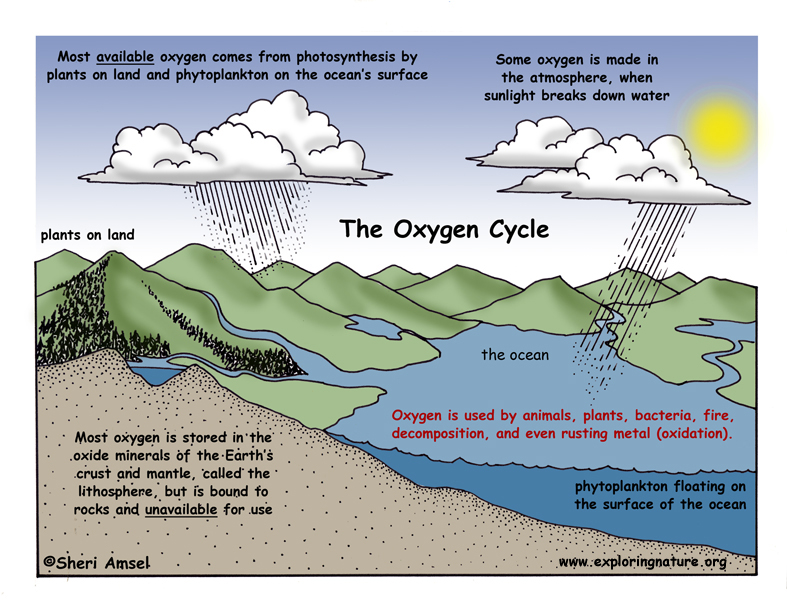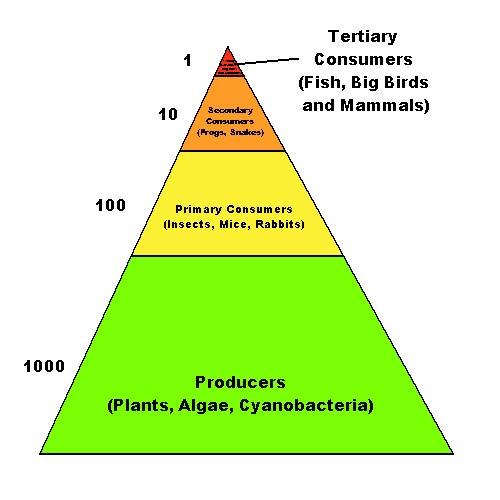So, what are the abiotic factors?
1. LIGHT
- specifically sunlight (solar energy) is the most important energy source in the biosphere
- light varies in amount, type (direct, indirect, spectrum) and distribution as a result of:
latitude
gradient
altitude
weather
vegetation
season
Plants have different tolerances to light (eg. high light tolerant vs. shade-tolerant)-
Light also has an effect on animal behaviour, for example depending on the time of day (level of light) different animals will be active or inactive.
2. TEMPERATURE
-dependent on solar radiation, as well as surface and air characteristics
eg. the type of surface determines heat absorption (grass vs. concrete)
eg. water and CO2 content of air determines the greenhouse effect
-seasonal variations associated with latitude
- variations with altitude (higher usually cooler)
- variations with gradient (eg. north slope vs. south slope)
- organisms exhibit different tolerance to temperatures (warm-loving vs. cool-loving, eurytherms - can handle a wide range of temperatures vs. stenotherms - can only handle a narrow range of temperatures)
- Bergman's Law: In homeotherms, the size of related animals' bodies can be correlated with the average temperature of the environment in which the animals live. Body size increases with decreased temperature (lowers the surface to volume ratio, so less body heat is lost at the surface, relative to that which is maintained internally)
-Allen's Law: Within related groups of mammals, the closer the given animals live to the poles the smaller their extremities (ears, length of legs, size of feet, etc) become. Once again, this is to reduce heat loss in cold climates, or to increase heat loss in hotter climates
3. AIR
- 78% N2, 21% O2, 1% everything else (CO2, H2, etc)
- the concentration of CO2 could (below 0.3%) limit the rate of photosynthesis (Liebig's law of the minimum)
- air pollution:
a) local: eg. sulfur dioxide is a concern. It becomes sulfuric acid (forming acid rain), leading to decreased plant growth or even death and decreasing the pH of water bodies
b) global: eg. CFC's (chlorofluorohydrocarbons) leading to ozone thinning
- wind is a force of air that has a significant effect on habitats and organisms (eg. erosion, or permanently bent trees, increased evaporation, pollination)
 |
- its distribution varies widely and affects the distribution of living organisms
- plants can either handle variations in water availability (drought-resistant) or they can require a relatively constant water supply
- animals also show variation in their tolerance to water loss (mammals can only lose about 15% of their water stores, while arthropods can lose up to 60%)
5. SOIL
- created from the Earth's surface, the product of long physical, chemical and biological processes
- the first step is physical (mechanical) weathering caused by water and temperature changes
- next is chemical weathering: oxidation and hydrolysis to form colloids (clay-like particles)
- biological processes add organic material (humus), which determines the "fertility" or nutritional content of the soil
- soil colloids (1-500nm) adsorb water and cations (as they are negatively charged)
- soil is usually mildly acidic, level of acidity determines organisms found there
- the physical characteristics of soil include its structure, temperature, air content and humidity
Biotic and abiotic factors are linked together by flow of energy and cycling of materials, so let's have a look at the biogeochemical cycles.
1. Carbon cycle
- plants can either handle variations in water availability (drought-resistant) or they can require a relatively constant water supply
- animals also show variation in their tolerance to water loss (mammals can only lose about 15% of their water stores, while arthropods can lose up to 60%)
5. SOIL
- created from the Earth's surface, the product of long physical, chemical and biological processes
- the first step is physical (mechanical) weathering caused by water and temperature changes
- next is chemical weathering: oxidation and hydrolysis to form colloids (clay-like particles)
- biological processes add organic material (humus), which determines the "fertility" or nutritional content of the soil
- soil colloids (1-500nm) adsorb water and cations (as they are negatively charged)
- soil is usually mildly acidic, level of acidity determines organisms found there
- the physical characteristics of soil include its structure, temperature, air content and humidity
Biotic and abiotic factors are linked together by flow of energy and cycling of materials, so let's have a look at the biogeochemical cycles.
1. Carbon cycle
 |
| http://commons.wikimedia.org/wiki/File:Carbon-cycle-full.jpg |
2. Oxygen cycle
 |
| http://www.exploringnature.org/db/detail.php?dbID=27&detID=1186 |
3. Nitrogen cycle
 |
| http://en.wikipedia.org/wiki/Nitrogen_cycle |
4. Phosphorus cycle
 |
| http://www.shmoop.com/ecology/phosphorus-cycle.html |
 |
| http://www.srh.noaa.gov/jetstream/atmos/hydro.htm |
The flow of energy refers to the movement of energy from the sun to phototrophs to autotrophs, in other words something like a food chain or food web.
 |
| http://www2.estrellamountain.edu/faculty/farabee/BIOBK/BioBookcommecosys.html |
Food chains and food webs indicate which organisms are at which trophic levels (producer, primary consumer, secondary consumer, tertiary consumer, decomposer).
 | ||||||
http://www.eng.buffalo.edu/shaw/student/m2_design/01_home/ksb/KSB_S2/Topic_2_EcosystemFoodChainandFoodWeb.htm
Energy transfer between levels is only about 10%, 90% is lost, as a result there are many more individuals at lower trophic levels than higher ones, most of the time. This can be represented graphically by pyramids, such as the pyramid of energy.
The following examples show in the top chain (grass, rabbit, fox), how the energy decrease correlates with a decrease in total numbers of organisms and the biomass (amount of living material) of those organisms. Occasionally this is not the case and while the pyramid of energy remains upright, the other pyramids are inverted.
|



No comments:
Post a Comment